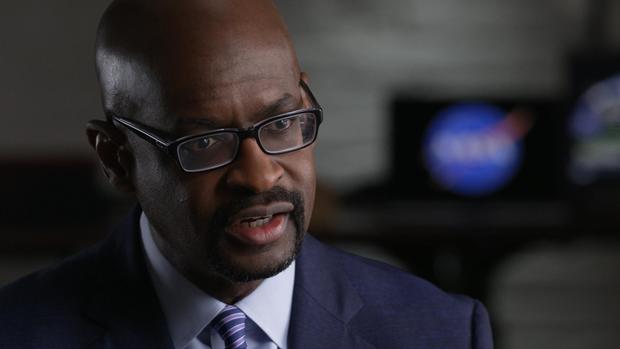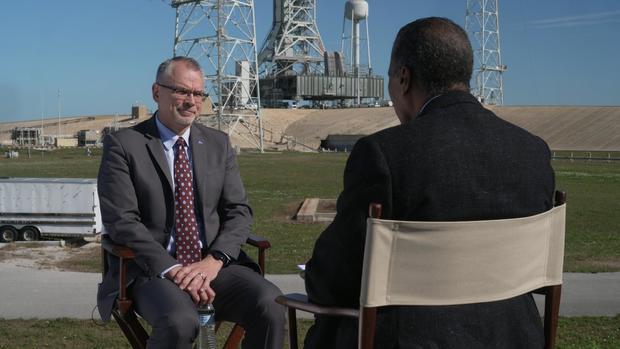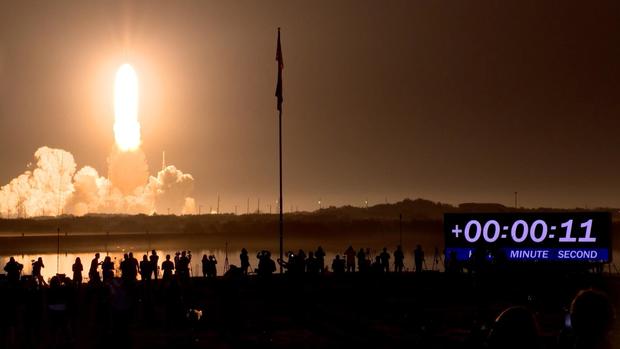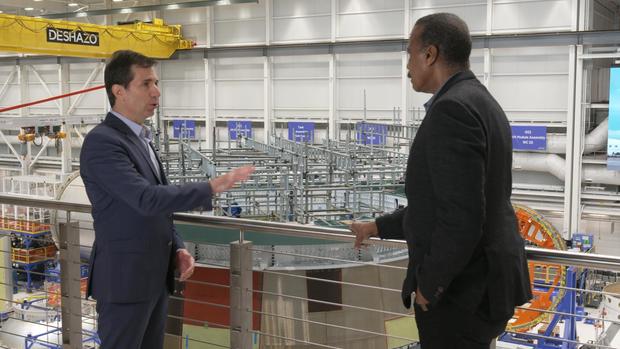CBS News
NASA is working with SpaceX and Blue Origin to land U.S. astronauts back on the moon
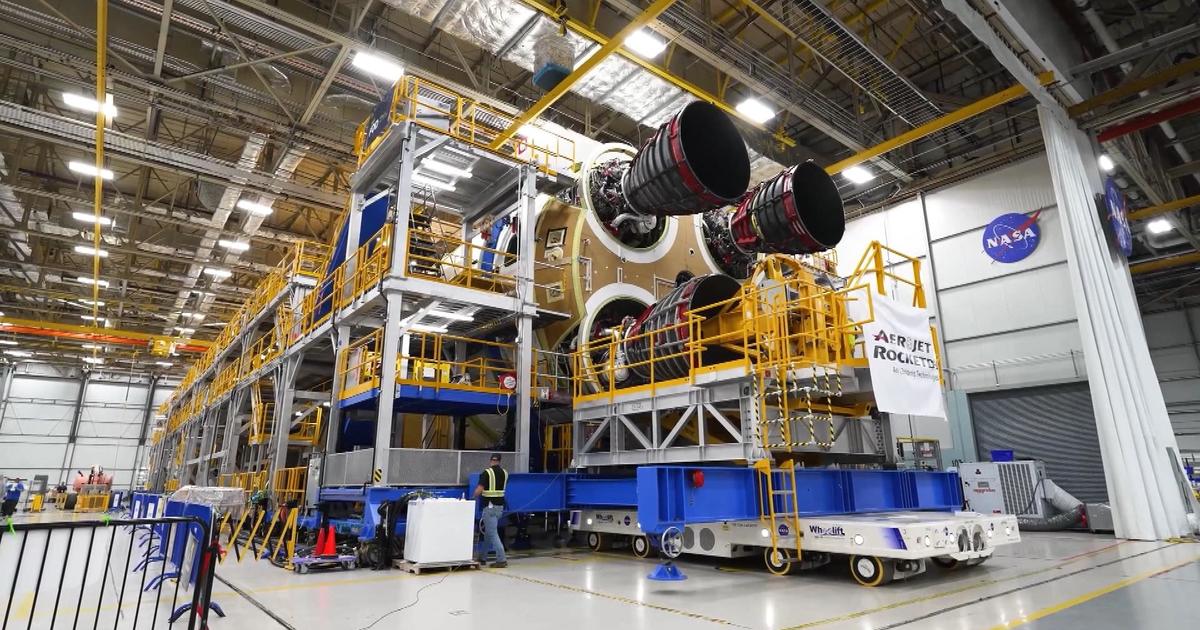
A small robotic lander built by a private company and carrying a scientific payload for NASA touched down near the south pole of the moon 11 days ago… and promptly tipped over on its side. Even so, it’s the first American spacecraft to land on the moon in more than 50 years.
NASA has a much more ambitious lunar program – called Artemis – which aims to send people back to the moon, to establish an outpost at the south pole, and to push on from there to Mars.
We previewed Artemis here in 2021, but there are significant questions now about the program’s costs and its timetable. In January NASA announced its new target for a manned landing – late 2026 – a year later than planned. but as we discovered, even that may be unrealistic.
When Artemis I soared into space in November of 2022, it was the beginning of a nearly flawless mission. In its first test flight, NASA’s new space launch system rocket sent an empty Orion crew capsule on a 1.4 million mile flyby of the moon before a picture-perfect return to Earth.
The next flight – Artemis II – meant to carry four astronauts on a lunar flyby – was supposed to launch this year, and then a year later Artemis III would land the first woman and first person of color on the moon. It’s not working out quite that way.
George Scott: I think it is safe to say, without significant reductions in cost, better cost controls, better planning, this Artemis program on its current trajectory is not sustainable.
George Scott is NASA’s acting inspector general. Don’t be misled by the ‘acting’; he’s been a top agency watchdog for more than five years. While NASA’s engineers have their heads in the stars, it’s his job to bring them back to Earth, particularly when it comes to costs.
60 Minutes
George Scott: Right now, we’re– we’re estimating that per launch– the Artemis campaign will cost $4.2 billion per launch.
Bill Whitaker: Per launch?
George Scott: Per launch. That’s an incredible amount of money per launch. A lot of that hardware is just going to end up in the ocean, never to be used again.
Bill Whitaker: The– inspector general for NASA says that the costs for the Artemis program are simply unsustainable. Is he wrong?
Jim Free: We didn’t necessarily agree with their conclusions. We, we feel like we’ve taken an affordable path to do these missions.
Jim Free is NASA’s associate administrator, and directly in charge of Artemis. We met him at historic Launch Pad 39b, from which both Apollo and Artemis rockets have flown.
Jim Free: We believe that the rocket we have is best matched for the mission and frankly the only one in the world that can take crews to the moon.
But as George Scott said, most components of that SLS rocket end up in the ocean; they’re not reusable. And with the goal of building an outpost on the moon, Artemis will need a lot of those $4.2 billion rockets!
Bill Whitaker: It’s going to take launch after launch after launch to get all that stuff up there.
Jim Free: Yes. So the number of launches is daunting. But it’s– it’s hard to get people to the moon.
When America sent Neil Armstrong and 11 more astronauts to the moon a half century ago, they got to the lunar surface aboard landers…owned and operated by NASA.
Bill Whitaker: You’re taking a different approach this time than with Apollo. What’s– what’s the difference this time?
Jim Free: The difference is we’re buying it as a service. We’re paying someone to take our crews down and take them up.
60 Minutes
That someone is Elon Musk. In 2021, NASA signed a nearly $3 billion contract with his SpaceX to use its new Starship mega-rocket as the lunar lander for the first Artemis astronauts.
SpaceX is preparing for its third Starship launch atop its enormous super-heavy booster. The first two launches both ended in roughly the same way.
Announcer (during SpaceX broadcast): As you can see, the super-heavy booster has just experienced a rapid unscheduled disassembly.
“Rapid unscheduled disassembly” is SpaceX-speak for “our Starship rocket just blew up,” again.
Bill Whitaker: And now you’ve seen some of the perils of relying on SpaceX.
Jim Free: We’ve seen some of the challenges they’ve had on Starship. We need them to launch several times– to give us the confidence that we can put our crews on there.
Bill Whitaker: But right now, as we sit here today, you have no way of getting the astronauts to the surface of the moon because of these problems that SpaceX has faced?
Jim Free: Because they haven’t– they haven’t hit the technical milestones.
SpaceX’s stated plan is to first put its Starship lander into low earth orbit, then launch 10 more starship tankers to pump rocket fuel into the lander in space…
… before sending it onward to meet astronauts in lunar orbit.
Bill Whitaker: And this has never been done before?
Jim Free: There’s been small-scale transfers in orbit, but not of this magnitude.
Bill Whitaker: It just sounds incredibly complicated.
Jim Free: It– it is complicated. There’s no doubt about that. It’s d– you don’t– you just– just launch ten times kind of on a whim.
George Scott: If it’s never been done before, chances are it’s going to take longer than you think to do it, and to do it successfully, and– and prove that technology before we trust putting humans on it. There is a long way to go.
NASA
NASA’s contract with SpaceX requires the company to make an un-manned lunar landing with Starship before trying one with astronauts on board. But NASA still says the manned mission can happen in two and a half years.
Bill Whitaker: And that just seems like the time frame we’re talking about, the end of 2026, seems ambitious to say the least.
Jim Free: What we’re doing is ambitious And it’s a great goal to have. To do that–
Bill Whitaker: Is the goal realistic?
Jim Free: I believe it is. I– I believe it is.
Jim Free’s optimism is based on SpaceX’s track record with its smaller Falcon rocket.
Once it got the Falcon up and running, it demonstrated it can launch a lot – 96 times last year alone, with both commercial and government payloads. But so far Starship has yet to reach orbit even once.
Bill Whitaker: Does that concern you, that that’s going to keep pushing that timeline back further–
Jim Free: Of course it absolutely concerns me because we need them to launch multiple times.
SpaceX ignored our multiple requests for an interview or comment. But in an interview with “The Daily Wire” in January, Elon Musk said this:
Elon Musk (in “Daily Wire” interview): We’re hoping to have first humans on the moon in less than 5 years.
Jim Free: My view of that is we have a contract with SpaceX that says they’re going to launch our crew in the end of 2026.
Why does it really matter when we get back to the moon? Here’s why: China has said it plans to send its “taikonauts” to the moon by the end of the decade, and NASA Administrator Bill Nelson has publicly expressed concern.
Bill Nelson (during 8/8/23 briefing): Naturally, I don’t want China to get to the South Pole first with humans and then say, “This is ours, stay out.”
To ensure that the U.S. will plant its flag first, NASA signed a new $3 billion contract last year with Blue Origin, the space company owned by billionaire Jeff Bezos, to build another lunar lander. And Jim Free is crystal clear that he sees it as an option if SpaceX Starships keep blowing up.
Jim Free: If we have a problem with one– we– we’ll have another one to rely on. If we have– a dependency on a particular aspect in– in SpaceX or Blue Origin and it doesn’t work out, then we have another lander that can take our crews.
In this battle of the star-gazing billionaires, Bezos’ Blue Origin has far fewer launches than Musk’s SpaceX, and has been far quieter about its ambitions… until now.
John Couluris: So what we’re looking to do is not only get to the moon and back, but make it reliable, and repeatable, and low cost.
60 Minutes
John Couluris’s title at Blue Origin is “senior vice president of lunar permanence,” and it says a lot about the company’s ambition.
John Couluris: The landers that Blue Origin’s going to be building are reusable. We’ll launch them to lunar orbit. And we’ll leave them there. And we’ll refuel them in orbit, so that– multiple astronauts can use the same vehicle back and forth.
Our cameras were among the first to be allowed inside Blue Origin’s huge complex in Florida, just next to Kennedy Space Center.
Bill Whitaker: This is where the future is being built.
John Couluris: That’s right. This is the main factory floor for the New Glenn rocket.
New Glenn is Blue Origin’s first heavy lift rocket. Its maiden launch will be sometime this year.
John Couluris: So you can see over here we have three different second stages already in build here.
The first New Glenn is already out at Blue Origin’s launch complex. It’s designed to carry all sorts of payloads, including the lunar lander being built for NASA.
John Couluris: So this is the Mark 1 lander. We call this our small lander.
Bill Whitaker: This is the small one?
John Couluris: Yes.
It’s actually a mock-up of their cargo lander, in Blue Origin’s Florida lobby. John Couluris used to work at SpaceX, and he came over to Blue to help speed things up.
Bill Whitaker: Is there a bit of a space race between you and SpaceX?
John Couluris: So the country needs competition. We need options. Competition brings innovation.
Blue Origin
Bill Whitaker: But you haven’t had anything close to the accomplishments that SpaceX has had at this point, have you?
John Couluris: SpaceX has done some amazing things. And they’ve changed the narrative for access to space. And Blue Origin’s looking to do the same. This lander, we’re expecting to land on the moon between 12 and 16 months from today.
Bill Whitaker: 12 and 16 months from today–
John Couluris: Yes. Yes. And I understand I’m saying that publicly. But that’s what our team is aiming towards.
Bill Whitaker: But that’s for, that’s for the cargo lander. What about humans?
John Couluris: For humans, we’re working with NASA on the Artemis V mission. That’s planned for 2029.
That’s not so different from Elon Musk’s forecast of when SpaceX can land humans back on the moon… even if it doesn’t match NASA’s. Like the Starship, Blue Origin’s lander will require in-space re-fueling, but Couluris insists that it and their rocket will help NASA trim costs.
John Couluris: Our New Glenn vehicle will be– a reusable vehicle from its first mission. That lander for the astronauts is a reusable lander. So now you’re not just taking the equipment and throwing it away. You’re reusing it for the next mission.
Bill Whitaker: You do it again, and again, and again. Is that where the cost savings comes in?
John Couluris: Exactly. We are now building with NASA, the infrastructure to ensure lunar permanency.
Bill Whitaker: You have said that the Artemis program is the beginning, not the end. Tell me, what is the future you see?
Jim Free: I see us landing on Mars. Absolutely see us landing on Mars. But we have to work through the moon to get to mars.
Bill Whitaker: These are magnificent goals, you know, going back to the moon, going to Mars. Do we have the ability to do what we’re dreaming of doing?
George Scott: You know, this is NASA. Right? This agency is destined to continue to do great things. There’s no question about that. What we’re telling the agency is, “Just be more realistic.” There’s nothing wrong with being optimistic. In fact, it’s required. Right? In this business, optimism is required. The question is though, can you also be more realistic?
Produced by Rome Hartman. Associate producer, Sara Kuzmarov. Broadcast associate, Mariah B. Campbell. Edited by Craig Crawford.
CBS News
Coal use hitting all-time high in 2024, which is on track to be hottest year ever, report says

World coal use is set to reach an all-time high in 2024, the International Energy Agency said Wednesday, in a year all but certain to be the hottest in recorded history.
Despite calls to halt humanity’s burning of the filthiest fossil fuel driving climate change, the energy watchdog expects global demand for coal to hit record highs for the third year in a row.
Scientists have warned that planet-warming greenhouse gases will have to be drastically slashed to limit global heating to avoid catastrophic impacts on the Earth and humanity.
Earlier in December, the European Union’s climate monitor Copernicus said 2024 was “effectively certain” to be the hottest on record — eclipsing the mark set just last year.
Published on Wednesday, the IEA’s “Coal 2024” report does, however, predict the world will hit peak coal use in 2027 after topping 8.77 billion tons this year.
But that would be dependent on China, which for the past quarter-century has consumed 30 percent more coal than the rest of the world’s countries combined, the IEA said.
China’s demand for electricity was the most significant driving force behind the increase, with more than a third of coal burnt worldwide carbonized in that country’s power plants.
Though Beijing has sought to diversify its electricity sources, including a massive expansion of solar and wind power, the IEA said China’s coal demand in 2024 will still hit 4.9 billion tones — itself another record.
Increasing coal demand in China, as well as in emerging economies such as India and Indonesia, made up for a continued decline in advanced economies.
However that decline has slowed in the European Union and the United States. Coal use there is set to decline by 12 and five percent respectively, compared with 23 and 17 percent in 2023.
With the imminent return to the White House of Donald Trump — who has repeatedly called climate change a “hoax” — many scientists fear that a second Trump presidency would water down the climate commitments of the world’s largest economy.
Coal mining also hit unprecedented levels by topping nine billion tons in output for the first time, the IEA said, with top producers China, India and Indonesia all posting new production records.
The energy watchdog warned that the explosion in power-hungry data centers powering the emergence of artificial intelligence was likewise likely to drive up demand for power generation, with that trend underpinning electricity demand in coal-guzzling China.
The 2024 report reverses the IEA’s prediction last year that coal use would begin declining after peaking in 2023.
At the annual U.N. climate change forum in Dubai last year, nations vowed to transition away from fossil fuels.
But its follow-up this year ended in acrimony, with experts warning that the failure to double down on that landmark pledge at COP29 in Azerbaijan risked jeopardizing efforts to fight climate change.
Set up in the wake of the 1973 oil crisis, the IEA presents itself as “the world’s leading energy authority.”
CBS News
Tennessee DA accused of firing multiple times at fugitive, hitting home with woman and her 3 children inside

A district attorney in Tennessee is facing a reckless endangerment charge after shooting at a fugitive several times and hitting a home that had a woman and her three children inside.
The Tennessee Bureau of Investigation announced the grand jury charge Monday against District Attorney Chris Stanford. His district covers Van Buren and Warren counties.
The indictment says that as the incident unfolded in Smithville on Nov. 21, a bullet Stanford shot from his handgun went through a front porch patio chair, through an exterior wall and into the living room wall of the home. The woman and children weren’t hurt.
Smithville is about 60 miles southeast of Nashville.
The indictment says that Stanford fired the shot “unlawfully, intentionally and recklessly.” There was no immediate threat to him or others, he wasn’t aiming the handgun, and “just held it out and shot” without using the gun’s sights, the indictment adds.
Following his indictment, Stanford surrendered at the DeKalb County Jail and was released after posting a $10,000 bond, TBI said. A message left with Stanton’s office was not immediately returned Tuesday.
The Warren County Sheriff’s Office described the circumstances leading to the incident last month. In a social media post, it said authorities were pursuing suspects after finding three dead bodies at a house and at an adjacent building.
The suspects were sighted in DeKalb County, the sheriff’s office said. One of them was taken into custody without incident. Stanford and other law enforcement officials chased the other suspect, who was a passenger in a car, the office said.
While trying to help the suspect flee, the driver struck a homeland security officer with the car, the sheriff’s office said.
In a statement last month to CBS affiliate WTVF-TV, Stanford said he fired shots in response to the homeland security agent being hit. No one was shot when Stanford fired his gun. The homeland security officer was injured and taken to the hospital, according to a social media post by District Attorney Bryant Dunaway.
“The vehicle then drove toward me and others, accelerating quickly. I fired my service weapon in defense of myself and others at the scene. Based upon my training and the circumstances that presented themselves, I believe my actions were necessary and justified,” Stanford said.
Stanford also told the news station he has a state law enforcement certification to carry his weapon at all times.
The two suspects in the three deaths were taken into custody and charged with criminal homicide, while the driver, also taken into custody, faces felony evading arrest and aggravated assault charged, according to the sheriff’s office.
Stanford will make an appearance in court on Jan. 7, WTVF reported. Since he showed up at the scene and fired his weapon, he is now a witness and cannot prosecute the triple murder in his own county, the station reported.
CBS News
Accused mastermind of journalist’s murder wanted by Mexico — but U.S. has called him a “protected witness”

Mexico has asked the United States to extradite the suspected mastermind behind the murder of journalist Javier Valdez after he was arrested on drug charges, the attorney general said.
Damaso Lopez Serrano — who the Justice Department says is known as “Mini Lic” — is accused of ordering the 2017 killing of Valdez, an award-winning journalist and AFP contributor who covered the narcotics trade.
The alleged former high-ranking member of the Sinaloa Cartel was arrested on Friday in Virginia on charges of trafficking fentanyl. Lopez Serrano is the son of Damaso Lopez Nunez, who launched a struggle for control of the cartel following the arrest of its leader, Joaquin “El Chapo” Guzman.
Mexico’s Attorney General Alejandro Gertz described Lopez Serrano as the “mastermind” behind Valdez’s murder.
“We have already prosecuted the rest of the perpetrators and they are in jail,” he told a news conference.
Valdez was shot and killed in his car on May 15, 2017 in the Sinaloa state capital of Culiacan near the offices of his weekly newspaper Riodoce.
Enric Marti / AP
Investigators believe Lopez Serrano ordered the hit because he was angry about information published by Valdez about the Sinaloa Cartel’s internal power struggles.
Mexico has made several extradition requests for Lopez Serrano, who surrendered to U.S. authorities in July 2017 for drug trafficking and cooperated in exchange for a reduced sentence. At the time, the U.S. Drug Enforcement Administration said Lopez Serrano was “believed to be the highest-ranking Mexican cartel leader ever to self-surrender in the United States.”
He was released from prison on parole in 2022.
Gertz said that Mexico had asked “on countless occasions” for Lopez Serrano to be handed over, but Washington declined because he had become a “protected witness” and “was giving them a lot of information.”
He voiced hope that with Lopez Serrano’s latest arrest “there are more than enough reasons” for the United States to finally grant Mexico’s request.
Rebecca Blackwell / AP
Wracked by violence related to drug trafficking, Mexico is one of the world’s most dangerous countries for journalists, news advocacy groups say.
Reporters Without Borders says more than 150 newspeople have been killed in Mexico since 1994 — and 2022 was one of the deadliest years ever for journalists in Mexico, with at least 15 killed.
Media workers are regularly targeted in Mexico, often in direct reprisal for their work covering topics like corruption and the country’s notoriously violent drug traffickers.
Most recently, in October, gunmen killed a journalist whose Facebook news page covered the violent western Mexico state of Michoacan. Then less than 24 hours later, an entertainment reporter in the western city of Colima was killed inside a restaurant she owned.


